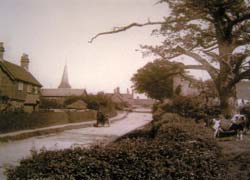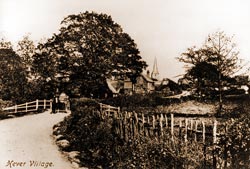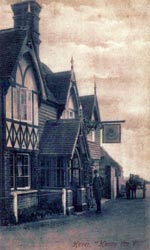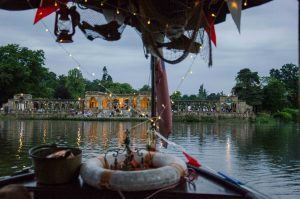HRA – a potted history
Hever Residents Association was formed in 1990 as a result of two happenings in the Village. In 1983 Baron Gavin Astor of Hever sold Hever Castle, and its vast estate was broken up.

Hever as it used to be…
The Village Circa 1905
For 80 years the Astors had effectively run Hever. They owned much of it and employed many local people. They ran football and cricket teams, organised social events, had Christmas parties for the children, built the school and the Village Hall (then a men’s reading room) and much much more. When they left, village cohesion ceased to exist, and many clubs and organisations slowly disintegrated.
Five years later, in 1988, Delaware Farm was broken up and sold off in small lots. This included land in Hever, some of which was bought at public auction by unscrupulous outsiders. Within a year, building work was in progress on six different sites. These were ostensibly agricultural barns, and as such were permitted development, and beyond the scope of planning law as it then stood.

Hever as it used to be…
Hever Road – date unknown
Although many individual Villagers were alarmed at what was happening, it seemed unstoppable. The Parish Council refused to get involved because no law was being broken. The Astors were gone, and there was no other body to turn to. One concerned resident, Austin Adkin, decided something had to be done. He enlisted the help of another resident, Jan Ryan, and together they sent out fifteen invitations to the most affected households, to attend a meeting at Austin’s house. That meeting took place on the evening of Wednesday 24th January 1990, and was attended by more than double the number of original direct invitees. It quickly became apparent at that meeting, that although the “barns” were the immediate concern, there was a need for a village-wide organisation to pull the village back together again and fill the void left by the Astors – thus HRA was born.

Hever as it used to be…
The Henry Circa 1920
Today the infamous barns are a distant memory. Only two were ever completed. One became the venue of illegal acid house parties, and HRA was instrumental in bringing about a successful prosecution. The other one was used as a decidedly non-agricultural vehicle repair shop, and HRA played a role in putting a stop to that, too. Thanks to HRA’s vigorous lobbying both barns were eventually removed. HRA was specifically quoted in the influential House of Lords Select Committee Report which led to the planning law being changed so that the problem cannot recur, here or anywhere else.
HRA has, over the years, fought and mostly won many battles on behalf of the village and its inhabitants. The infamous “concrete coffin” bridge on How Green Lane used to have even higher parapets and no sight lines at all at either end. Constant pressure from HRA eventually resulted in at least some modification.
In the 1990s the now thriving Hever C of E Primary School almost closed when Kent County Council raised concerns over the lack of pupils. It was HRA, and in particular it’s then Chairman, Christopher Dane, that sought and achieved consent from the then Secretary of State for Education to raise enough funding (through covenants from local businesses and individuals, including HRA) to keep the village school open for the vital four years it needed to prove its viability. Without this HRA support to the Governors there would not, now, be a village school.
At the other end of the village, the 42 lights at Hever station used to shine out across the countryside like candles on a birthday cake. HRA, after a long period of negotiation, succeeded in getting shades over the lamps, with instant, and dramatic results.
On many planning matters potentially damaging to the village, HRA has been vociferous, and at appeal hearings has so far achieved a 100% success rate.
There have been many events which HRA has helped run in collaboration with other local organisations for the benefit to the village. The street party held to celebrate the 50th anniversary of VE day left a permanent reminder in the shape of the Beacon on the Parish Field, and other parties included the Millennium New Year’s Eve Celebrations in the school the Queen’s Silver Jubilee at the village hall and the Queen’s 90th birthday party at Hever Castle.
HRA holds a number of annual village events as well as working to improve the village, for more details see the home page.
Since its single issue beginning in January 1990, HRA has tackled many and varied village matters and continues to work towards its stated aim – “to preserve, protect and if possible improve” the lovely Kent village of Hever.